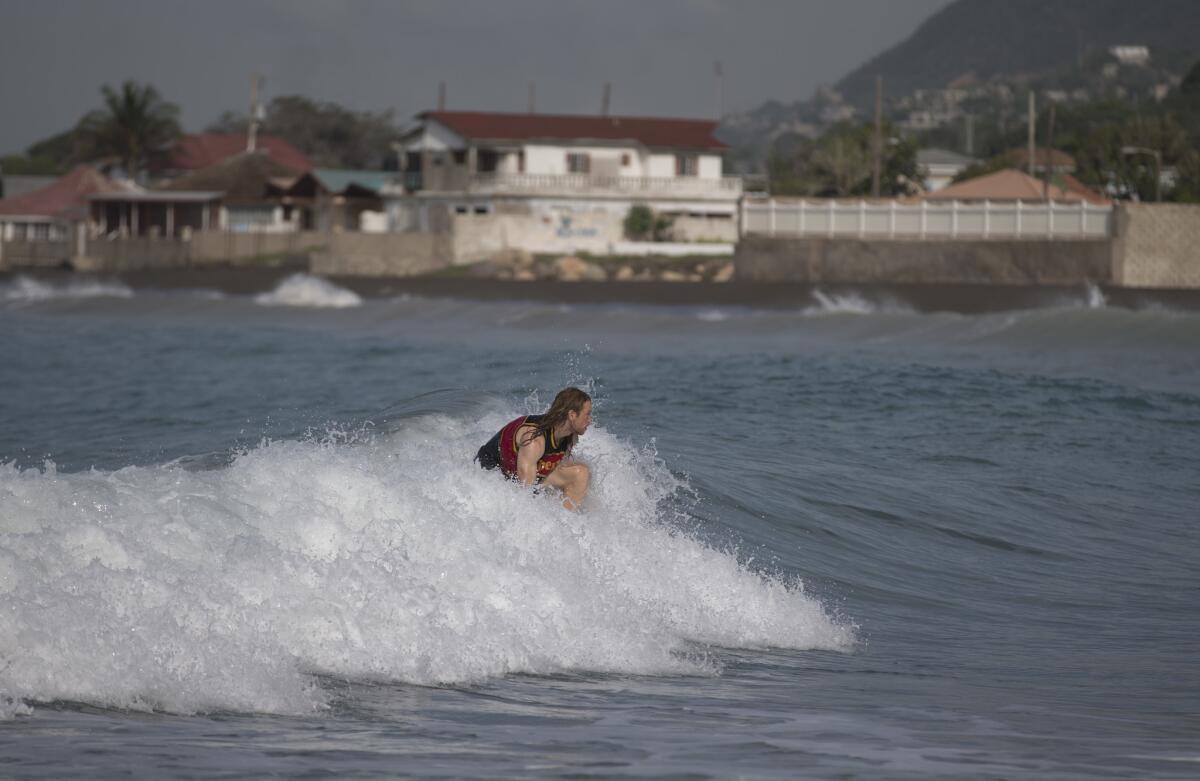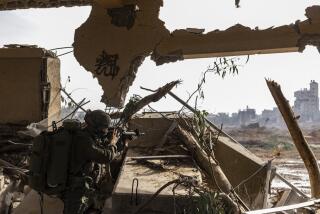Powerful Hurricane Matthew threatens Haiti, Jamaica and Cuba

Reporting from PORT-AU-PRINCE, Haiti — A powerful Hurricane Matthew moved slowly Sunday across the Caribbean Sea on a track that authorities warned could trigger devastation in parts of Haiti.
The storm had winds of 145 mph as it moved northwest and the center was expected to pass across or very close to the southwestern tip of Haiti late Monday before reaching Cuba, according to the U.S. National Hurricane Center in Miami.
A hurricane warning was in effect for Jamaica, Cuba and Haiti. Forecasters said the southern Haitian countryside around Les Cayes could see the worst of it.
“Wherever that center passes close to would see the worst winds and that’s what’s projected to happen for the western tip of Haiti,” said John Cangilosi, a hurricane specialist at the center. “There is a big concern for rains there and also a big concern for storm surge.”
Matthew is one of the most powerful Atlantic hurricanes in recent history and briefly reached the top classification, Category 5, becoming the strongest hurricane since Felix in 2007. The hurricane center said it appeared to be on track to pass east of Florida through the Bahamas, but it was too soon to predict with certainty whether it would reach the coast of the United States.
The government of Haiti opened 1,300 emergency shelters across the country, enough to hold up to 340,000 people. Authorities broadcast warnings over the radio and across social media, trying to counter a common tendency for people to try to stay in their homes to protect them during natural disasters.
“The shelters are open but I don’t believe we have anyone inside them just yet,” said Joseph Edgard Celestin, a spokesman for the civil protection agency.
Teams of civil protection officials were walking the streets of Les Cayes urging residents to secure their homes, prepare emergency kits and warn their neighbors. Many Haitians appeared unaware of the looming hurricane.
“No, I haven’t heard anything about a bad storm coming here,” farmer Jean-Bernard Mede said with a concerned expression as he took a break from walking three cows along a dirt track outside the town of Leogane. “I’ll do what I can for my animals and my family.”
Forecasters said the slow-moving Matthew was expected to dump 15 to 25 inches of rain over southern Haiti, with a few places getting as much as 40 inches.
The impoverished country is particularly vulnerable to devastating floods because of the steep terrain, with hillsides and mountains often devoid of the trees that hold back the water because they have been cut down to make charcoal for cooking fires. Many people often live in houses that are not able to withstand a storm, typically built of scraps of wood with flimsy corrugated-steel roofs.
As of 2 p.m. EDT, the storm was centered about 335 miles south-southwest of Port-au-Prince, Haiti. It was traveling north-northwest at 5 mph.
A hurricane watch was posted for the southeastern Bahamas and Turks and Caicos Islands. A tropical storm warning was in effect for parts of the Dominican Republic, where authorities began mandatory evacuations of areas at risk for flooding.
The hurricane earlier had been projected to move closer to Jamaica, but the risk to the island seems to have diminished somewhat.
“The center of the system is looking more likely that it will pass to the east of Jamaica but it won’t miss it by that much, so they are still going to see impacts,” Cangilosi said. “The impacts are maybe going to be a little lower there than they would be in Haiti and eastern Cuba.”
After passing Jamaica and Haiti, Matthew is expected to reach Cuba, potentially striking near the U.S. Navy base at Guantanamo Bay, where authorities were evacuating non-essential personnel, including about 700 family members of those serving there.
Everyone remaining behind was being told to take shelter, said Julie Ann Ripley, a spokeswoman. There are about 5,500 people living on the base, including 61 men held at the detention center.
Cuban President Raul Castro traveled to the eastern city of Santiago to oversee preparations for Matthew’s arrival. A report on state television showed the 85-year-old leader discussing the hurricane’s path with ministers and saying, “This is a hurricane we need to prepare for as if it were twice as powerful as Sandy,” the 2012 hurricane that devastated much of Cuba’s second-largest city.
Hundreds of troops were moving in convoys around the city and state workers with chain saws were cutting trees overhanging power lines and homes. Trains from Havana to eastern Cuba were canceled and the government called on residents of eastern Cuba to move livestock to high ground, tape up their windows and store potable water ahead of the hurricane’s arrival.
The forecast track would also carry Matthew into the Bahamas. Cangilosi said the storm appeared to tracking toward the U.S., but it was too soon to say if it would affect Florida or parts of the East Coast.
“The message we have for people in Florida is just closely monitor Matthew,” he said. “We can’t rule out any significant impacts just yet but the indications at this point are that the center of it will move to the east.”
ALSO
Philippine president apologizes to Jews for Hitler remark
Dozens killed during stampede at religious celebration in Ethiopia
More to Read
Sign up for Essential California
The most important California stories and recommendations in your inbox every morning.
You may occasionally receive promotional content from the Los Angeles Times.








